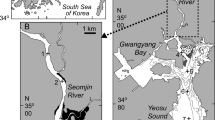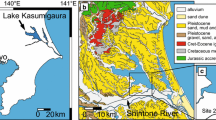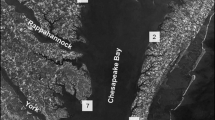Abstract
Most studies on Arctic food webs have neglected microphytobenthos as a potential food source because we currently lack robust measurements of δ13C values for microphytobenthos from this environment. As a result, the role of microphytobenthos in high latitude marine food webs is not well understood. We combined field measurements of the concentration of aqueous carbon dioxide and the stable carbon isotopic composition of dissolved inorganic carbon (δ13CDIC) from bottom water in the Beaufort and Chukchi seas with a set of stable carbon isotopic fractionation factors reflecting differences in algal taxonomy and physiology to estimate the stable carbon isotope composition of microphytobenthos-derived total organic carbon (δ13Cp). The δ13Cp for Phaeodactylum tricornutum, a pennate diatom likely to be a dominant microphytobenthos taxon, was estimated to be −23.9 ± 0.4 ‰ as compared to a centric diatom (Porosira glacialis, δ13Cp = −20.0 ± 1.6 ‰) and a marine haptophyte (Emiliana huxleyi, δ13Cp = −22.7 ± 0.5 ‰) at a growth rate (µ) of 0.1 divisions per day (d−1). δ13Cp values increased by ~2.5 ‰ when µ increased from 0.1 to a maximum growth rate of 1.4 d−1. We compared our estimates of δ13Cp values for microphytobenthos with published measurements for other carbon sources in the Arctic and sub-Arctic. We found that microphytobenthos values overlapped with pelagic sources, yet differed from riverine and ice-derived carbon sources. These model results provide valuable insight into the range of possible isotopic values for microphytobenthos from this region, but we remain cautious in regard to the conclusiveness of these findings given the paucity of field measurements currently available for model validation.


Similar content being viewed by others
References
Alderson B, Mazumder D, Saintilan N, Zimmerman K, Mulry P (2013) Application of isotope mixing models to discriminate dietary sources over small-scale patches in saltmarsh. Mar Ecol Prog Ser 487:113–122
Arrigo KR, Perovich DK, Pickart RS, Brown ZW, van Dijken GL et al (2012) Massive phytoplankton blooms under Arctic Sea ice. Science 336:1408
Bates NR (2001) Interannual variability of oceanic CO2 and biogeochemical properties in the Western North Atlantic subtropical gyre. Deep Sea Res II 48:1507–1528
Blanchard GF (1990) Overlapping microscale dispersion patterns of meiofauna and microphytobenthos. Mar Ecol Prog Ser 68:101–111
Boller AJ, Thomas PJ, Cavanaugh CM, Scott KM (2011) Low stable carbon isotope fractionation by coccolithophore RuBisCO. Geochim Cosmochim Acta 75:7200–7207
Budge SM, Wooller MJ, Springer AM, Iverson SJ, McRoy CP, Divoky GJ (2008) Tracing carbon flow in an Arctic marine food web using fatty acid-stable isotope analysis. Oecologia 157:117–129
Cahoon LB (1999) The role of benthic microalgae in neritic ecosystems. Oceanogr Mar Biol Annu Rev 37:47–86
Cahoon LB, Redman RS, Tronzo CR (1990) Benthic microalgal biomass in sediments of Onslow Bay, North Carolina. Estuar Coast Shelf Sci 31:805–815
Carmack E, Barber D, Christensen J, Macdonald R, Rudels B, Sakshaug E (2006) Climate variability and physical forcing of the food webs and the carbon budget on panarctic shelves. Prog Oceanogr 71:145–181
Coffin RB, Smith JP, Plummer RE, Yoza B, Larsen RK et al (2013) Spatial variation in shallow sediment methane sources and cycling on the Alaskan Beaufort Sea Shelf/Slope. Mar Petrol Geol 45:186–197
Dunton KH, Schonberg SV, Cooper LW (2012) Food web structure of the Alaskan nearshore shelf and estuarine lagoons of the Beaufort Sea. Estuar Coast 35:416–435
Emerson S, Hedges J (2008) Life processes in the ocean. In: Emerson S, Hedges J (eds) Chemical oceanography and the marine carbon cycle. Cambridge University Press, Cambridge, pp 199–202
Evrard V, Soetaert K, Heip C, Huettel M, Xenopoulos MA, Middelburg JJ (2010) Carbon and nitrogen flows through the benthic food web of a photic subtidal sandy sediment. Mar Ecol Prog Ser 416:1–16
Evrard V, Huettel M, Cook P, Soetaert K, Heip C, Middelburg JJ (2012) Importance of phytodetritus and microphytobenthos for heterotrophs in a shallow subtidal sandy sediment. Mar Ecol Prog Ser 455:13–31
Farquhar GD, Ehleringer JR, Hubick KT (1989) Carbon isotope discrimination and photosynthesis. Annu Rev Plant Physiol 40:503–537
Fischer G (1991) Stable carbon isotope ratios of plankton carbon and sinking organic matter from the Atlantic sector of the Southern Ocean. Mar Chem 35:581–596
France RL (1995) Carbon-13 enrichment in benthic compared to planktonic algae: foodweb implications. Mar Ecol Prog Ser 124:307–312
Fry B, Wainright SC (1991) Diatom sources of 13C-rich carbon in marine food webs. Mar Ecol Prog Ser 76:149–157
Giordano M, Beardall J, Raven JA (2005) CO2 concentrating mechanisms in algae: Mechanisms, environmental modulation, and evolution. Annu Rev Plant Biol 56:99–131
Glud RN, Woelfel J, Karsten U, Kuhl M, Rysgaard S (2009) Benthic microalgal production in the Arctic: applied methods and status of the current database. Bot Mar 52:559–571
Goñi MA, Yunker MB, Macdonald RW, Eglinton TI (2000) Distribution and sources of organic biomarkers in arctic sediments from the Mackenzie River and Beaufort Shelf. Mar Chem 71:23–51
Goñi MA, Yunker MB, Macdonald RW, Eglinton TI (2005) The supply and preservation of ancient and modem components of organic carbon in the Canadian Beaufort Shelf of the Arctic Ocean. Mar Chem 93:53–73
Griffith DR, McNichol AP, Xu L, McLaughlin FA, Macdonald RW et al (2012) Carbon dynamics in the western Arctic Ocean: insights from full-depth carbon isotope profiles of DIC, DOC, and POC. Biogeosciences 9:1217–1224
Gruber N, Keeling CD, Bacastow RB, Guenther PR, Lueker TJ et al (1999) Spatiotemporal patterns of carbon-13 in the global surface oceans and the oceanic Suess effect. Global Biogeochem Cycles 13:307–335
Haimovich-Dayan M, Garfinkel N, Ewe D, Marcus Y, Gruber A et al (2013) The role of C4 metabolism in the marine diatom Phaeodactylum tricornutum. N Phytol 197:177–185
Hecky RE, Hesslein RH (1995) Contributions of benthic algae to lake food webs as revealed by stable isotope analysis. J N Am Benthol Soc 14:631–653
Hobson KA, Welch HE (1992) Determination of trophic relationships within a high arctic marine food web using δ13C and δ15N analysis. Mar Ecol Prog Ser 84:9–18
Hobson KA, Ambrose WG, Renaud PE (1995) Sources of primary production, benthic–pelagic coupling, and trophic relationships within the Northeast Water Polynya: Insights from δ13C and δ15N analysis. Mar Ecol Prog Ser 128:1–10
Hobson KA, Fisk A, Karnovsky N, Holst M, Gagnon JM, Fortier M (2002) A stable isotope (δ13C, δ15N) model for the North Water food web: Implications for evaluating trophodynamics and the flow of energy and contaminants. Deep Sea Res II 49:5131–5150
Holmden C, Creaser RA, Muehlenbachs K, Leslie SA, Bergstrom SM (1998) Isotopic evidence for geochemical decoupling between ancient epeiric seas and bordering oceans: implications for secular curves. Geology 26:567–570
Horner R, Schrader GC (1982) Relative contributions of ice algae, phytoplankton, and benthic microalgae to primary production in nearshore regions of the Beaufort Sea. Arctic 35:485–503
Iken K, Bluhm BA, Gradinger R (2005) Food web structure in the high Arctic Canada Basin: evidence from δ13C and δ15N analysis. Polar Biol 28:238–249
Iken K, Bluhm B, Dunton K (2010) Benthic food-web structure under differing water mass properties in the southern Chukchi Sea. Deep Sea Res II 57:71–85
Ishida K, Green BR (2002) Second- and third-hand chloroplasts in dinoflagellates: phylogeny of oxygen-evolving enhancer 1 (PbsO) protein reveals replacement of a nuclear-encoded plastid gene by that of a haptophyte tertiary endosymbiont. Proc Natl Acad Sci 99:299–306
Karsten U, Schumann R, Rothe S, Jung I, Medlin L (2006) Temperature and light requirements for growth of two diatom species (Bacillariophyceae) isolated from an Arctic macroalga. Polar Biol 29:476–486
Kennedy H, Thomas DN, Kattner G, Haas C, Dieckmann GS (2002) Particulate organic matter in Antarctic summer sea ice: concentration and stable isotopic composition. Mar Ecol Prog Ser 238:1–13
Kirst GO, Wiencke C (1995) Ecophysiology of polar algae. J Phycol 31:181–199
Korb RE, Raven JA, Johnston AM, Leftley JW (1996) Effects of cell size and specific growth rate on stable carbon isotope discrimination by two species of marine diatom. Mar Ecol Prog Ser 143:283–288
Krebs WN (1983) Ecology of neritic marine diatoms, Arthur Harbor, Antarctica. Micropaleontology 29:267–297
Laws EA, Ditullio GR, Redalje DG (1987) High phytoplankton growth and production rates in the North Pacific subtropical gyre. Limnol Oceanogr 32:905–918
Laws EA, Popp BN, Bidigare RR, Kennicutt MC, Macko SA (1995) Dependence of phytoplankton carbon isotopic composition on growth-rate and CO2 (aq): theoretical considerations and experimental results. Geochim Cosmochim Acta 59:1131–1138
Lewis ER, Wallace DWR (1995) Basic programs for the CO2 system in seawater, Rep. BNL-61827; Brookhaven Natl. Lab., Upton, NY
Longhi ML, Schloss IR, Wiencke C (2003) Effect of irradiance and temperature on photosynthesis and growth of two antarctic benthic diatoms, Gyrosigma subsalinum and Odontella litigiosa. Bot Mar 46:276–284
Macdonald RW, Naidu AS, Yunker MB, Gobeil C (2004) The Beaufort Sea: distribution, sources, fluxes and burial or organic carbon. In: Stein R, Macdonald RW (eds) The organic carbon cycle in the Arctic Ocean. Springer, Berlin, pp 177–192
Matheke GEM, Horner R (1974) Primary productivity of the benthic microalgae in the Chukchi Sea near Barrow, Alaska. J Fish Res Board Can 31:1779–1786
McGee D, Laws RA, Cahoon LB (2008) Live benthic diatoms from the upper continental slope: extending the limits of marine primary production. Mar Ecol Prog Ser 356:103–112
McMahon KW, Ambrose WG, Johnson BJ, Sun MY, Lopez GR et al (2006) Benthic community response to ice algae and phytoplankton in Ny Alesund, Svalbard. Mar Ecol Prog Ser 310:1–14
McTigue ND, Dunton KH (2014) Trophodynamics and organic matter assimilation pathways in the northeast Chukchi Sea, Alaska. Deep Sea Res II 102:84–96
Medlin L, Barker G, Campbell L, Green J, Hayes P et al (1996) Genetic characterisation of Emiliania huxleyi (Haptophyta). J Mar Syst 9:13–31
Middelburg JJ, Barranguet C, Boschker H, Herman P, Moens T, Heip C (2000) The fate of intertidal microphytobenthos carbon: an in situ 13C-labeling study. Limnol Oceanogr 45:1224–1234
Moran SB, Lomas MW, Kelly RP, Gradinger R, Iken K, Mathis JT (2012) Seasonal succession of net primary productivity, particulate organic carbon export, and autotrophic community composition in the eastern Bering Sea. Deep Sea Res II 65–70:84–97
Naidu AS, Scalan RS, Feder HM, Goering JJ, Hameedi MJ, Parker PL, Behrens EW, Caughey ME, Jewett SC (1993) Stable organic carbon isotopes in sediments of the north Bering- south Chukchi seas, Alaskan-Soviet Arctic Shelf. Cont Shelf Res 13:669–691
Naidu AS, Cooper LW, Finney BP, Macdonald RW, Alexander C, Semiletov IP (2000) Organic carbon isotope ratios (δ13C) of Arctic Amerasian Continental shelf sediments. Int J Earth Sci 89:522–532
Oakes JM, Eyre BD (2014) Transformation and fate of microphytobenthos carbon in subtropical, intertidal sediments: potential for long-term carbon retention revealed by 13C-labeling. Biogeosciences 11:1927–1940
Oakes JM, Revill AT, Connolly RM, Blackburn SI (2005) Measuring carbon isotope ratios of microphytobenthos using compound-specific stable isotope analysis of phytol. Limnol Oceanogr 3:511–519
Oakes JM, Connolly RM, Revill AT (2010a) Isotope enrichment in mangrove forests separates microphytobenthos and detritus as carbon sources for animals. Limnol Oceanogr 55:393–402
Oakes JM, Eyre BD, Middelburg JJ, Boschker H (2010b) Composition, production, and loss of carbohydrates in subtropical shallow subtidal sandy sediments: rapid processing and long-term retention revealed by 13C-labeling. Limnol Oceanogr 55:2126–2138
Oakes JM, Eyre BD, Middelburg JJ (2012) Transformation and fate of microphytobenthos in subtropical shallow subtidal sandy sediments: a 13C-labeling study. Limnol Oceanogr 57:1846–1856
Palmer MA, van Dijken GL, Mitchell BG, Seegers BJ, Lowry KE et al (2013) Light and nutrient controls of photosynthesis in natural plankton populations from the Chukchi and Beaufort Seas, Arctic Ocean. Limnol Oceanogr 58:2185–2205
Pancost RD, Freeman KH, Wakeham SG, Robertson CY (1997) Controls on carbon isotope fractionation by diatoms in the Peru upwelling region. Geochim Cosmochim Acta 61:4983–4991
Patterson WP, Walter LM (1994) Depletion of 13C in seawater ΣCO2 on modern carbonate platforms: significance for the carbon isotopic record of carbonates. Geology 22:885–888
Pickart RS, Moore GWK, Torres DJ, Fratantoni PS, Goldsmith RA, Yang JY (2009) Upwelling on the continental slope of the Alaskan Beaufort Sea: Storms, ice, and oceanographic response. J Geophys Res Oceans 114:C00A13. doi:10.1029/2008JC005009
Popp BN, Laws EA, Bidigare RR, Dore JE, Hanson KL, Wakeham SG (1998) Effect of phytoplankton cell geometry on carbon isotopic fractionation. Geochim Cosmochim Acta 62:69–77
Smyth T, Tyrrell T, Tarrant B (2004) Time series of coccolithophore activity in the Barents Sea, from twenty years of satellite imagery. Geophys Res Lett 31:L11302. doi:10.1029/2004GL019735
Søreide JE, Carroll ML, Hop H, Ambrose WG, Hegseth EN, Falk-Petersen S (2013) Sympagic–pelagic–benthic coupling in Arctic and Atlantic waters around Svalbard revealed by stable isotopic and fatty acid tracers. Mar Biol Res 9:831–850
Torres ME, Mix AC, Rugh WD (2005) Precise δ13C analysis of dissolved inorganic carbon in natural waters using automated headspace sampling and continuous-flow mass spectrometry. Limnol Oceanogr 3:349–360
Van den Meersche K, Soetaert K, Middelburg JJ (2011) Plankton dynamics in an estuarine plume: a mesocosm 13C and 15N tracer study. Mar Ecol Prog Ser 429:29–43
von Quillfeldt CH, Ambrose WG Jr, Clough LM (2003) High number of diatom species in first-year ice from the Chukchi Sea. Polar Biol 26:806–818
Wang SW, Budge SM, Gradinger RR, Iken K, Wooller MJ (2014) Fatty acid and stable isotope characteristics of sea ice and pelagic particulate organic matter in the Bering Sea: tools for estimating sea ice algal contribution to Arctic food web production. Oecologia 174:699–712
Whitledge T, Malloy SC, Patton CJ, Wirick CD (1981) Automated nutrient analyses in seawater. United States Department of Energy and Environment, Upton, NY
Wulff A, Iken K, Quartino ML, Al-Handal A, Wiencke C, Clayton MN (2009) Biodiversity, biogeography and zonation of marine benthic micro- and macroalgae in the Arctic and Antarctic. Bot Mar 52:491–507
Acknowledgments
This research was funded as part of “An interdisciplinary monitoring mooring in the western Arctic boundary current: Climatic forcing and ecosystem response” (Arctic Observing Network NSF Award #0856244) and NSF Award # ARC-0902177. This paper comprises part of Laura Oxtoby’s PhD thesis research. We are indebted to the crew of the US Coast Guard Cutter Healy for assistance with sample collection. We thank Jessica Cross, Claudine Hauri, and Stacey Reisdorph for field measurements of carbon parameters. We also thank Andrew Ross, Oregon State University Stable Isotope Laboratory, for conducting sample analysis. Katrin Iken, Shiway Wang, Kyungcheol Choy, and Benjamin Gaglioti provided thoughtful commentary on the manuscript prior to submission. We are grateful to the editor (Dr. Piepenburg) and two anonymous reviewers for their helpful comments on our original manuscript.
Author information
Authors and Affiliations
Corresponding author
Ethics declarations
Conflicts of interest
The authors have no conflicts of interest to declare.
Research involving human participants and/or animals
This article does not contain any studies with human participants or animals performed by any of the authors.
Informed consent
Informed consent was obtained from all individual participants included in the study.
Electronic supplementary material
Below is the link to the electronic supplementary material.
Rights and permissions
About this article
Cite this article
Oxtoby, L.E., Mathis, J.T., Juranek, L.W. et al. Estimating stable carbon isotope values of microphytobenthos in the Arctic for application to food web studies. Polar Biol 39, 473–483 (2016). https://doi.org/10.1007/s00300-015-1800-2
Received:
Revised:
Accepted:
Published:
Issue Date:
DOI: https://doi.org/10.1007/s00300-015-1800-2




